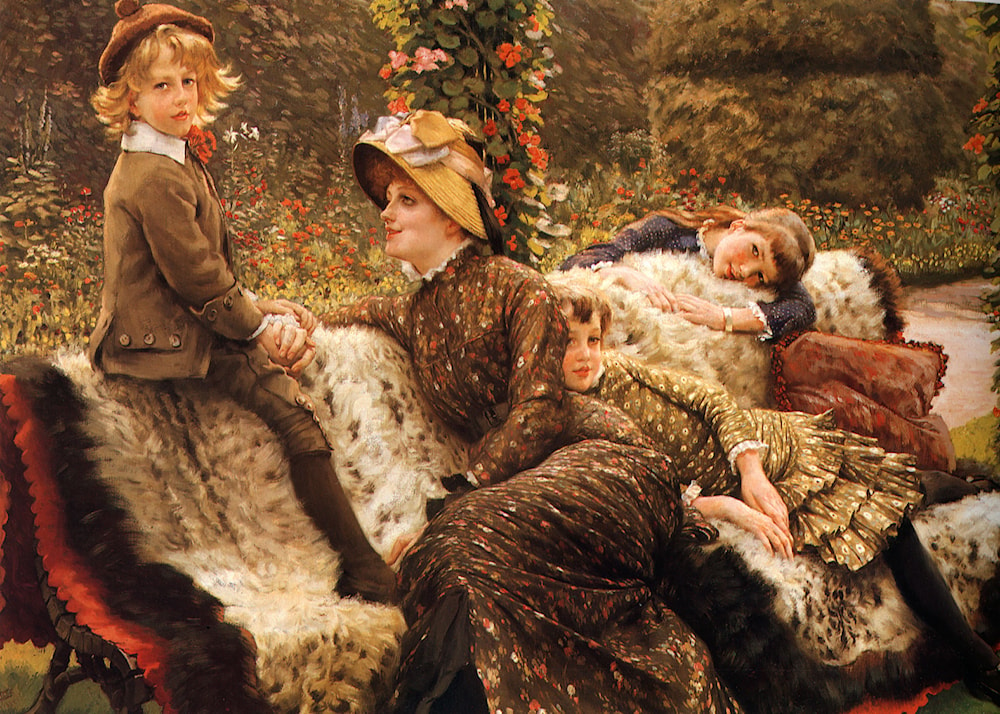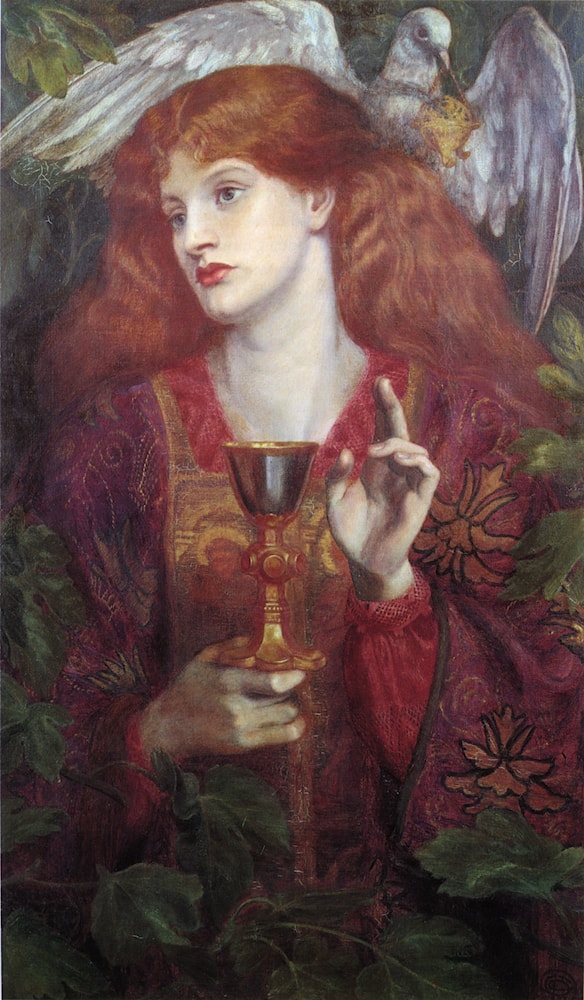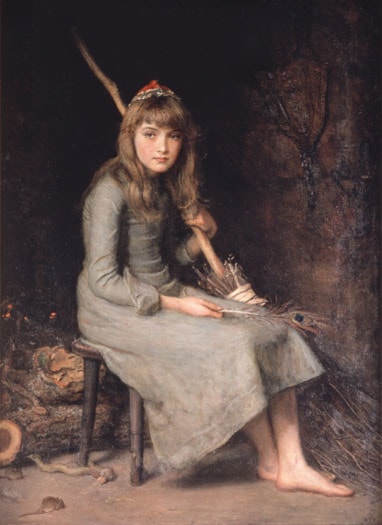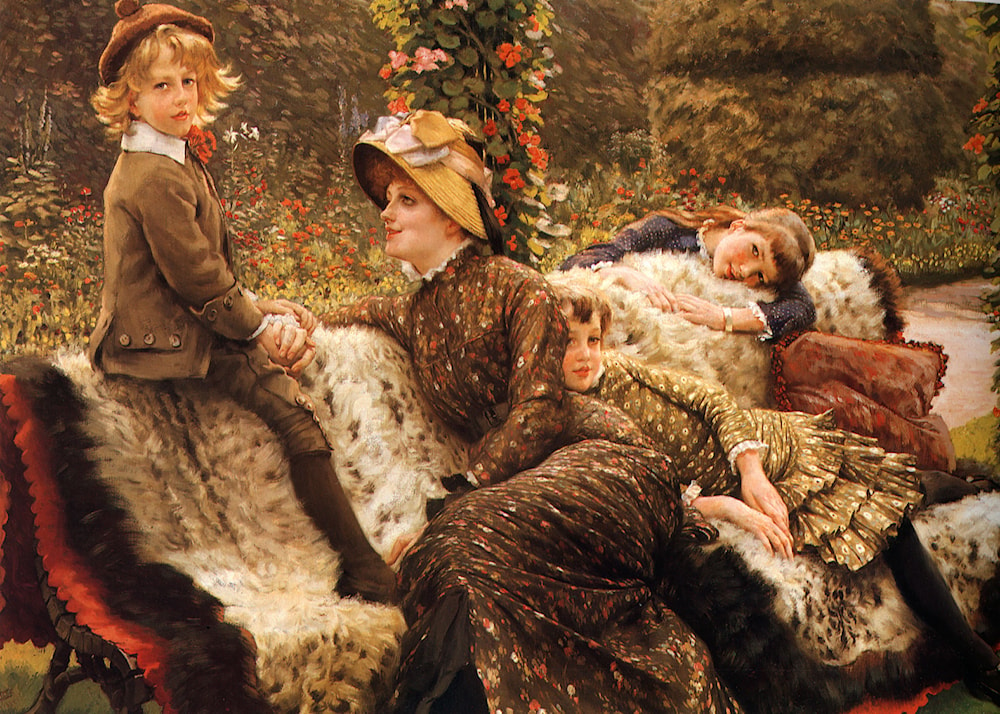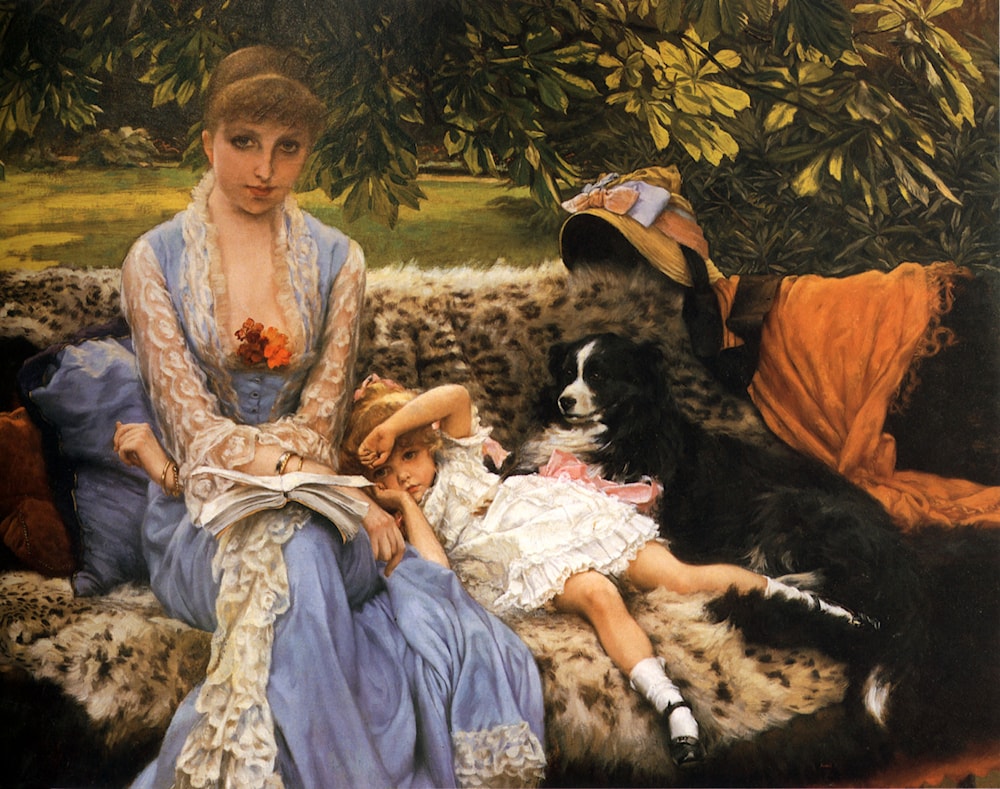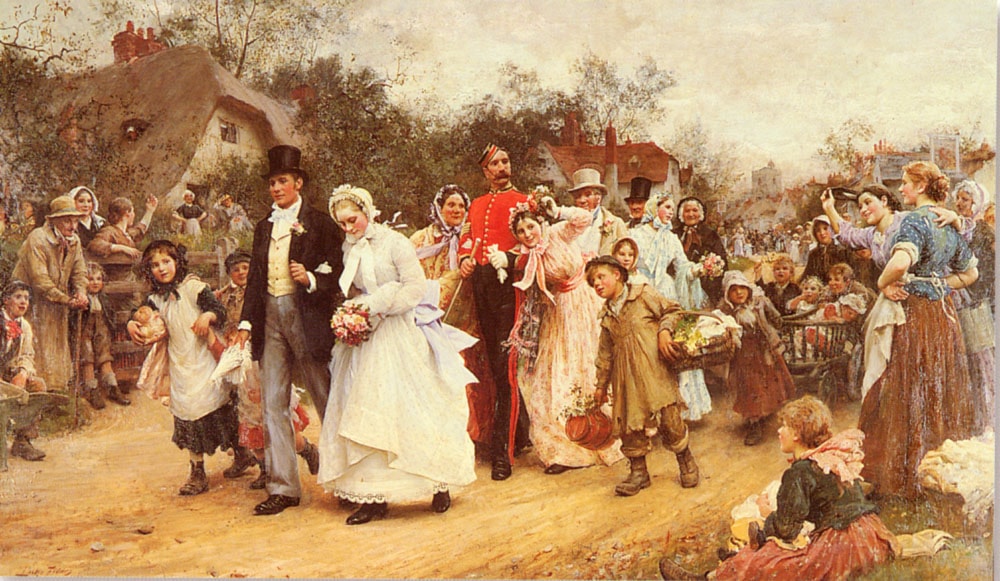Pre-Raphelites and Other Masters

The Lloyd Webber collection has to be seen to be believed. Anyone interested in the Pre-Raphaelites and Victorian art simply has to get on a plane, a ship, a train, a bus, a taxi, or their own two feet, and reach the Royal Academy before December 12th.
There are not many people whose collection could fill the entire main rooms of the Royal Academy. But then Andrew Lloyd Webber is no ordinary person. Known to the world as a writer of highly successful musicals, he has also been, for the last thirty-five years, a passionate and committed collector of Victorian painting. It is often said of Andrew that he writes musicals to collect more paintings, and it is true. Collecting is his real obsession.
I first met Andrew in the late 1960's when I was working at Christie's, and had just begun organising Victorian sales. A very casually dressed young man, with long dark hair down to his shoulders, came in to see me, introduced himself, and said he was interested in the Pre-Raphaelites. We went down to the basement, and looked at a few things coming up in my next sale. It was the beginning of a friendship that has lasted for over thirty years.
Andrew had already started collecting before I met him. He bought his first picture, a Rossetti drawing, when still a teenager. In this he was following the example of the painter L. S. Lowry, who likewise collected Rossetti as soon as his pictures began to make money in the 1950's. In his early days, Andrew did not have the money to buy the best things on the market. By the time I met him, he had written Jesus Christ Superstar, and his fortunes were beginning to flourish. But he was not the public figure that he is today. I once asked Andrew to dinner, and the lady sitting next to him asked what he did. "I'm a composer," replied Andrew. "Oh impoverished, I suppose?" she answered.
As I have often said, and written, collecting is not all about money. I have known many remarkable collectors who were not at all rich. Collecting is really about dedication, commitment, patience, taste, and above all, knowledge. Andrew has taught himself an immense amount about Victorian art, architecture and decorative arts. He knows as much, if not more, than many dealers and academics. Like me, he was involved for a time with the Victorian Society.
During the 1970's and 80's, Andrew's collection grew steadily. His focus at this time was still very much the Pre-Raphaelites, their followers and associates. Then in the 1990's, the extraordinary success of Andrew's musicals meant that he could buy the very best things, and he did. He paid $5m. for Tissot's Garden Bench and $6m. for St Cecilia, both record prices for Victorian paintings. In this decade, Andrew began to widen the collection, buying across the whole range of Victorian art, but still never losing an opportunity to acquire anything important by the Pre-Raphaelites. He is still collecting now, and bought several pictures at the Forbes sale in February, which are in the exhibition. The Forbes sale was one of numerous collections broken up during the 1990's, which gave Andrew more marvellous opportunities.

But Andrew's greatest love has always been the Pre-Raphaelites, and they form the core of the collection, and the exhibition. Above all, he has always been an admirer of Burne-Jones , by whom he has over 40 works, paintings, gouaches, watercolours, and drawings. He also has one of the three sets of the Holy Grail tapestries. The only other complete set is in Birmingham City Art Gallery. The third set has been split up.Andrew has examples of Burne-Jones's work from his earliest drawings for The Fairy Family, through to late masterpieces such as The Challenge in the Wilderness. He also has one of the two Pygmalion sets of four, as well as studies for such famous works as The Mirror Of Venus, King Cophetua and The Lament. This has led to an equal enthusiasm for the work of Burne-Jones's lifelong friend and collaborator, William Morris , and his associates, in particular William De Morgan. Andrew also has a beautiful group of child portraits by Burne-Jones, Gaskell, Mattersdorf and Philip Comyns Carr, which are among the most haunting, and charming works in the exhibition. In this range of works, we can see how Burne-Jones developed from a Pre-Raphaelite and pupil of Rossetti, into one of the fathers of European Symbolism, and thus[undoubtedly to the dissatisfaction of his spirit] also one of the influences on the modern movements of the 20th century.

Inevitably, Andrew has always been equally dedicated to the work of Rossetti, who is also strongly represented. Here again there are drawings, watercolours and pastels from all periods of Rossetti's career, as well as major oils, such as The Damsel of Sanct Grael and A Vision of Fiametta the poster-girl of the exhibition. All of Rossetti's models make their appearance, Fanny Cornforth, Alexa Wilding, Marie Stillman, and Jane Morris. There is even Rossetti's only full-length nude, The Spirit of the Rainbow, which belonged to Evelyn Waugh. Next to Burne-Jones, the Rossetti's form the most important group in Andrew's collection.





But neither have the other two PRBs, Holman Hunt and Millais been neglected. The portraits of the Wyatt family by Millais were painted in 1849, the first year of the Brotherhood. The Proscribed Royalist of 1852-3, is a major work painted before the dissolution of the Brotherhood in 1853. Andrew also has smaller versions of Ophelia, A Huguenot and Sir Isumbras. Among later Millais, he has chosen well, particularly with two wonderful landscapes, Chill October (admired by the young van Gogh in London) and The Old Garden. Millais has still not been sufficiently recognised as a landscape painter. Yes and Cinderella are both good examples of Millais's later style. Also not to be missed is the extraordinary design for a gothic window of 1853.

Holman Hunt is represented by fewer works, but two of them are major items, Shadow of Death, the third version of the subject, and the enchanting Hilary — The Tracer, a portrait of Hunt's son, which used to hang in Diana Holman Hunt's drawing room in Onslow Gardens.


Arthur Hughes , never a member of the PRB, but one of their closest associates, is particularly well represented, with several major examples, The Knight Of The Sun, The King's Orchard, and Ophelia. There is also a small version of what is probably Hughes's best-loved picture, April Love. Among other followers and associates, Andrew has sought out superb examples by Michael Frederick Halliday , Frederick Sandys , Maria Stillman , Simeon Solomon , Spencer Stanhope , J. M. Strudwick , E. R. Frampton and many others.

Andrew has always understood the importance of Pre-Raphaelite landscape, and this is an area in which the collection is full of gems. Chief of these is John Brett's extraordinary The Val d Aosta of 1858, the picture inspired by Ruskin , but later rejected, and sold, by him. There are two beautiful Hunt landscapes, and one by Ford Madox Brown , the one artist not as fully represented in the collection as he might have been, but his work is now fantastically rare. There are also several early Pre-Raphaelite landscapes by Atkinson Grimshaw , another artist Andrew has collected avidly. There are no less than fourteen works by him in the exhibition, including night scenes, and the wonderful aesthetic interior Dulce Domum. There is also Richard Dadd's lone fairy masterpiece, Contradiction — Oberon and Titania, perhaps the most remarkable picture in the collection. How is it, members of the public might wonder, works like this are not in the Tate Gallery? Andrew's collection is, to a large degree, what the Tate Gallery should have bought over the last thirty years. They either couldn't, for lack of money, or wouldn't, for lack of foresight. That is how collectors get their chance.

Two artists with whom Andrew seems to have developed a particular affinity are Tissot and Waterhouse . The collection contains remarkable groups of both — eight by Tissot, twelve by Waterhouse. The Tissots are all of his London period, and the two finest are both of his mistress and muse, Kathleen Newton — L'Orpheline, and The Garden Bench. The Captain and the Mate is one of the finest examples of his scenes on board ship on the Thames, but some of the most pleasing of all are such small intimate studies as Uncle Fred or Quiet. In the same breath as Tissot, I might mention the staggering Boldini portrait of the legendary Marchesa Casati, surely the greatest portrait of the belle époque.



The Waterhouses also form an incredible group, ranging from the early Ophelia of 1889. As a dazzling row of major works, Saint Cecilia, The Danaides, Pandora, and The Awakening of Adonis, and Ophelia. There are also some drawings, and oil sketches, which are surprisingly loosely painted, reminding one that Waterhouse was a contemporary of the Impressionists and the Newlyn School.


An area where Andrew has missed opportunities in the early days was the neo-classical school, but he has made up for it since. He does not have a major classical work by Leighton , but the early Dante in Exile of 1864, is an unquestionable tour-de-force by a young artist. There are several works by Alma Tadema , and also several beautiful Albert Moore , Red Berries, and Light. Andrew has not flinched from buying the odd masterpiece of high Victorian [art - Ed.], such as Poynter's The Cave of the Storm Nymphs, or similar works by Frank Dicksee and Edmund Blair Leighton . G. F. Watts , surprisingly, is missing, a gap he should endeavour to fill.

Another side to the collection, and to Victorian art, is an extraordinary group of narrative pictures. This is an area that has interested Andrew since the early days, and he has therefore bought some of the best things to appear over the last thirty years. Luke Fildes's wonderful The Wedding, and Abraham Solomon's Class — The Meeting, are two of the most outstanding, but there are other works by Sir Joseph Noel Paton (In Memoriam), W. P. Frith , James Collinson , Frederick Goodall , Sophie Anderson , Fanny Fildes , and Edith Hayllar . I also consider John Henry Henshall's The Public Bar one of the masterpieces of social realism in English art.
Like many people interested in Victorian art, myself included, Andrew has also moved into the decorative arts. Painting and design were so interwoven in the 19th century, that collecting one is bound to lead to collecting the other. In every room of the exhibition, there are islands in the middle displaying furniture by Pugin, Burgess , and Philip Webb, and a painted piano by Kate Faulkner. There are William Morris carpets, and a truly staggering amount of pottery by William De Morgan. All this makes a nice counterpoint to the pictures on the wall, and reminds us of the inclusive nature of the collection. As if this was not enough, there are several beautiful manuscripts by Burne-Jones and Morris, and Kelmscott Press books.
Visitors may be surprised by the second-last room. Here are to be found, on one wall, a group of horse pictures by Alfred Munnings , and on the other, another group by Spencer. These collections reflect different interests — the Munnings Madeleine Lloyd Webber's passion for horse breeding and racing, and the Spencers the fact that Sydmonton Court, the Lloyd Webber's house, is a few miles from the celebrated Sandham Memorial Chapel, decorated with murals of the First World War by Spencer. Most critics are extraordinarily snooty about Munnings, but in my opinion, he is undoubtedly one of the finest horse painters who ever lived. I particularly like his early works of Exmoor ponies, and gypsies, and this is the period the Lloyd Webbers have concentrated on.
In the middle of the Munnings is hung Andrew's lone Picasso , the portrait of Angel de Soto. This Andrew bought to demonstrate that Picasso's blue period pictures show the influence of Burne-Jones, an artist the young Picasso in Barcelona was known to admire. Putting the Picasso among the Munnings is a little RA in-joke, as Munnings was well-known, and on record, as having intensely disliked Picasso's work. But only Andrew would have spent [for a Picasso in order to make] ... an art-historical point.
The room before the Munnings also contains two surprises — the Canaletto of Horse Guards Parade and a huge Reynolds of Prince Regent. Many critics have wondered why these two pictures are there. The answer is very simple. They are there because Andrew bought them. We are looking at a private collection, not a museum.
The press has made much of the fact that Andrew spent over $100m. on his collection. But that is not what makes it remarkable; indeed it is one of the most remarkable of all collections of English art ever assembled. It is the extraordinary single-mindedness and persistence with which Andrew has put together this amazing collection, that makes it so mind-bogglingly impressive. If, as Andrew promises, the collection is preserved together in a trust or foundation, in its own building, future generations many well marvel that one man was able to accumulate all this, in one lifetime. It is an incredible achievement. Hitherto, Andrew has always been reluctant to show his pictures, but seeing them at the Royal Academy has shown even him a new perspective on the collection, which he visits almost daily, to share his excitement with the visitors. I have not mentioned the catalogue, produced by the RA at breakneck speed, with excellent essays by Richard Dorment and others; this is also a must.
For me, being involved in Victorian pictures for the last 40 years, walking round the Lloyd Webber collection is an experience that is difficult to describe. Let's say it is my life in pictures. Not only do I remember almost every picture, but many of them went through my hands at one time, sometimes long before they reached Andrew. So the collection is also a history of collecting over the past generation. Go see it. What more can I say?
Acknowledgement
The Andrew Lloyd Webber Collection at the Royal Academy, London, until December 12, 2003. We extend our thanks to Christopher Wood for his gracious permission to republish this article. For those who want to learn more about England's foremost writer and broadcaster on Victorian art, we encourage you to visit his website at: www.ChristopherWoodGallery.com
A brief biography of the author
Christopher Wood was England's leading writer and broadcaster on Victorian art. He was educated at Sedbergh and St. John's College, Cambridge. From 1963 to 1976 he worked for the London auction house, Christie's, becoming director of Nineteenth Century Paintings.
In 1971 he published The Dictionary of Victorian Painters, still the standard work of reference, and later The Great Art Boom (1977) a study of art prices from 1970 to the present.
His other books include, Victorian Panorama, The Pre-Raphaelites, which has been translated in to Japanese and French, Tissot and Paradise Lost, Paintings of English Country Life and Landscape 1850-1914. In 1990 he wrote and presented a television series for Channel Four, entitled "Painters to the People". He also appears on the BBC Antiques Roadshow.
Since 1977 he ran his own gallery in London, specialising in Pre-Raphaelite and Victorian art, and in gothic furniture and the Arts and Crafts Movement.
His most recent books are Fairies in Victorian Art (2000) a large survey book, Victorian Painting (1999), and Victorian Paintings in Oils and Watercolours (1996). His book on the life and work of Sir Edward Coley Burne-Jones was published in 1998.
For further information, including a more comprehensive bibliographical listing, feel free to visit the Christoper Wood website at: Christopher Wood Gallery


